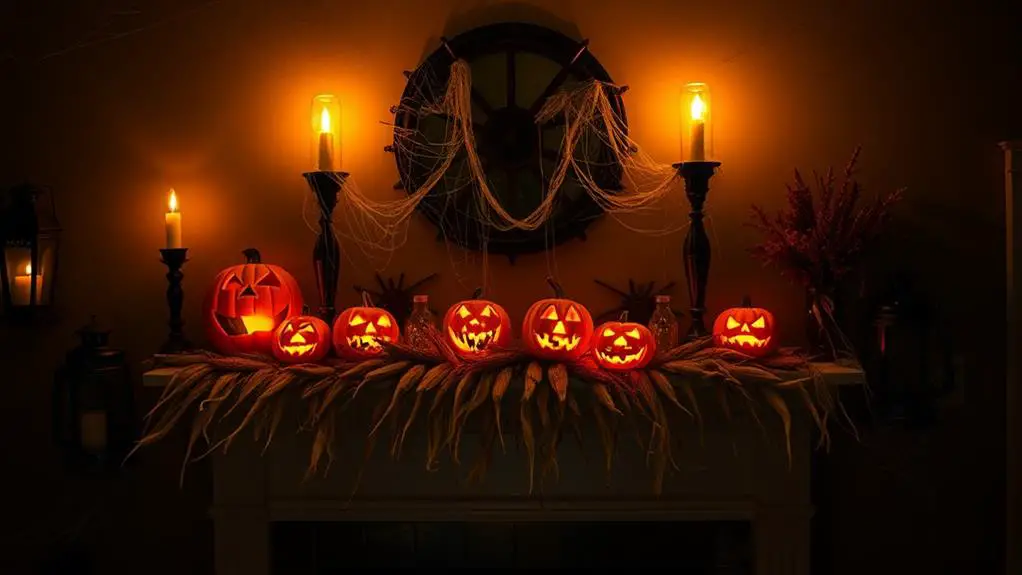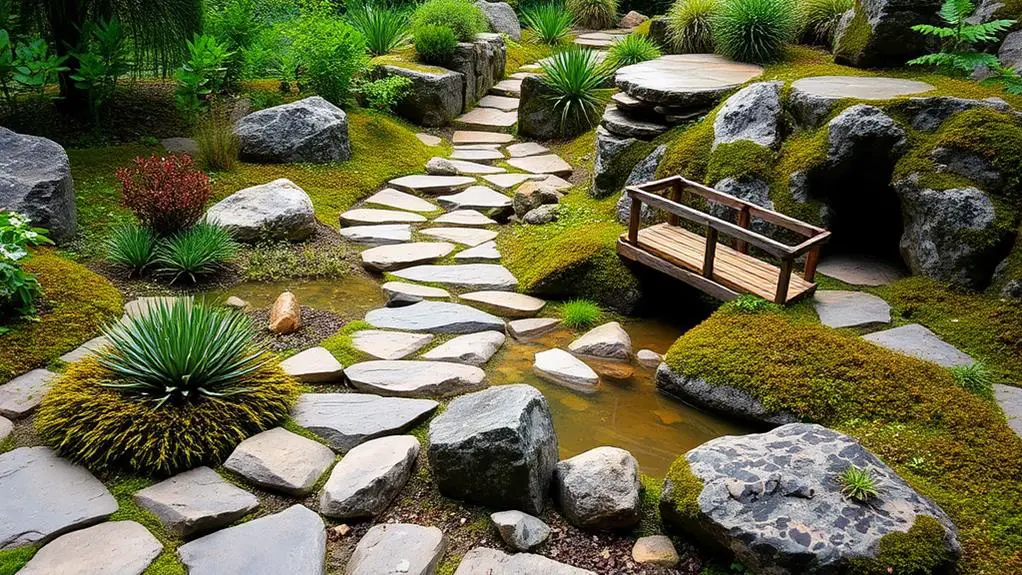As you envision your outdoor space, you're likely thinking about how to create a unique and mesmerizing feature that sets your garden apart. A DIY rock garden can be just that, offering endless possibilities for creativity and self-expression. By thoughtfully selecting rocks, plants, and decorative elements, you can craft a serene oasis or vibrant spectacle that reflects your personal style. But where do you start? With so many options to weigh, having a clear plan in place is crucial to bring your vision to life.
Summary
- Choose rocks with unique textures and colors to add visual interest and complement the garden's surroundings.
- Select low-maintenance plants like succulents and cacti that thrive in dry conditions and require minimal care.
- Balance large rocks with smaller plants to achieve harmony and create a sense of movement in the garden.
- Consider the scale and proportion of rocks and plants in relation to the garden's size to avoid overwhelming or underwhelming the space.
- Create a visually stunning layout by incorporating rock patterns, varying levels, and curves to guide visitors through the garden.
Selecting the Right Rocks
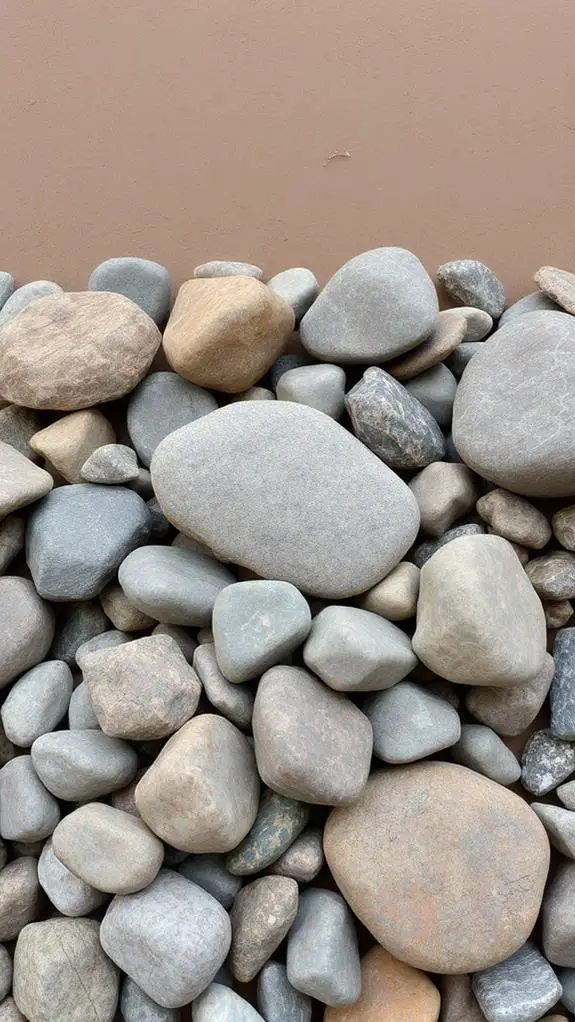
As you venture into creating your DIY rock garden, selecting the right rocks is essential to setting the tone and aesthetic of your outdoor space.
You'll want to ponder various rock types, such as granite, basalt, or limestone, each with its unique texture and character.
Rock colors also play a pivotal role, as they can complement or contrast with your garden's surroundings.
Neutral tones like beige, gray, and brown can blend seamlessly, while bold colors like red, orange, and yellow can add a pop of vibrancy.
Choosing Low-Maintenance Plants
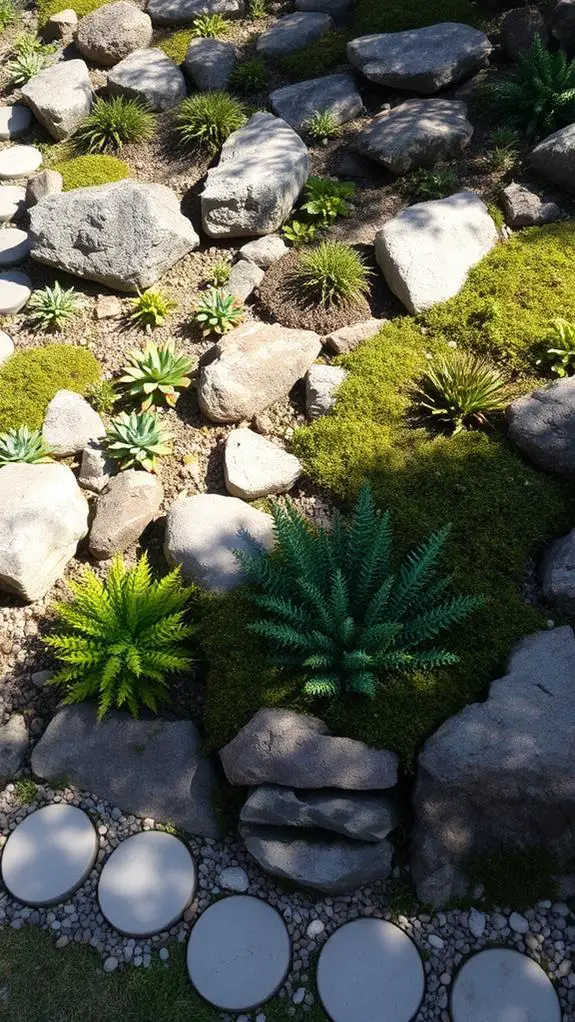
Your rock garden's plant selection is crucial to its overall appeal and your personal satisfaction.
You'll want to choose low-maintenance plants that thrive in dry conditions, as rock gardens often have poor soil and limited water supply. Consider Desert Dwellers like succulents and cacti, which store water in their leaves and stems.
These plants come in a variety of shapes, sizes, and colors, adding visual interest to your garden.
For a more whimsical look, incorporate Coastal Creepers like creeping thyme or sedum, which spread quickly and fill gaps between rocks.
These plants require minimal care and can tolerate extreme temperatures, making them perfect for a DIY rock garden.
Designing a Rock Garden Layout
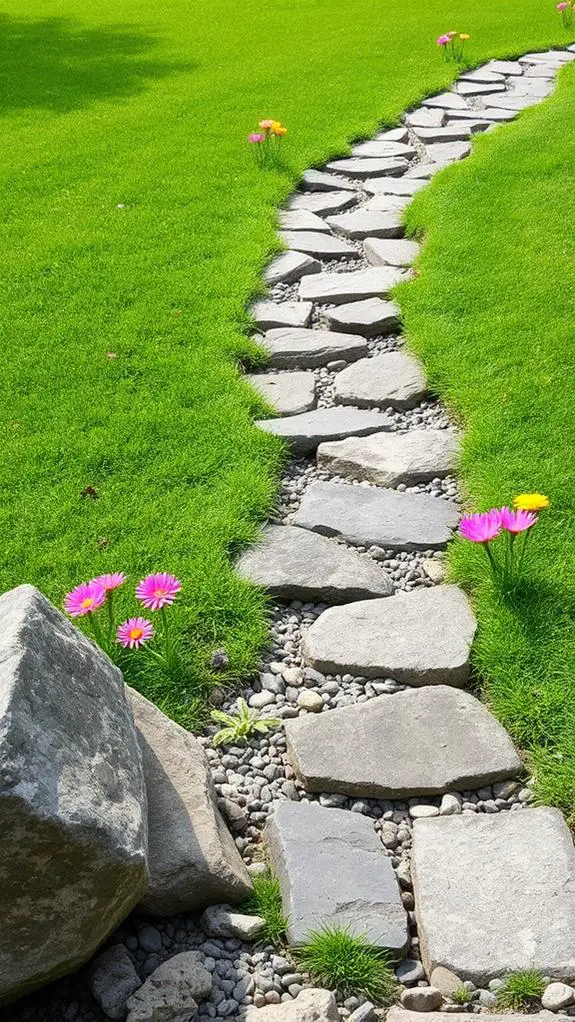
Now that you've selected the perfect low-maintenance plants for your DIY rock garden, it's time to think about the overall aesthetic you want to achieve.
Consider the scale of your garden and how you'll balance large rocks with smaller plants. Visualize the layout to guarantee harmony between elements.
Think about the flow of the garden, creating a sense of movement with curved paths or diagonal lines. Balance vertical elements like rocks and tall plants with horizontal elements like spreading groundcover.
Scale considerations are vital – large rocks can overwhelm small plants, while tiny rocks can get lost among larger plants. By carefully planning your layout, you'll create a visually stunning and harmonious rock garden that showcases your design skills.
Building a Rock Garden Border
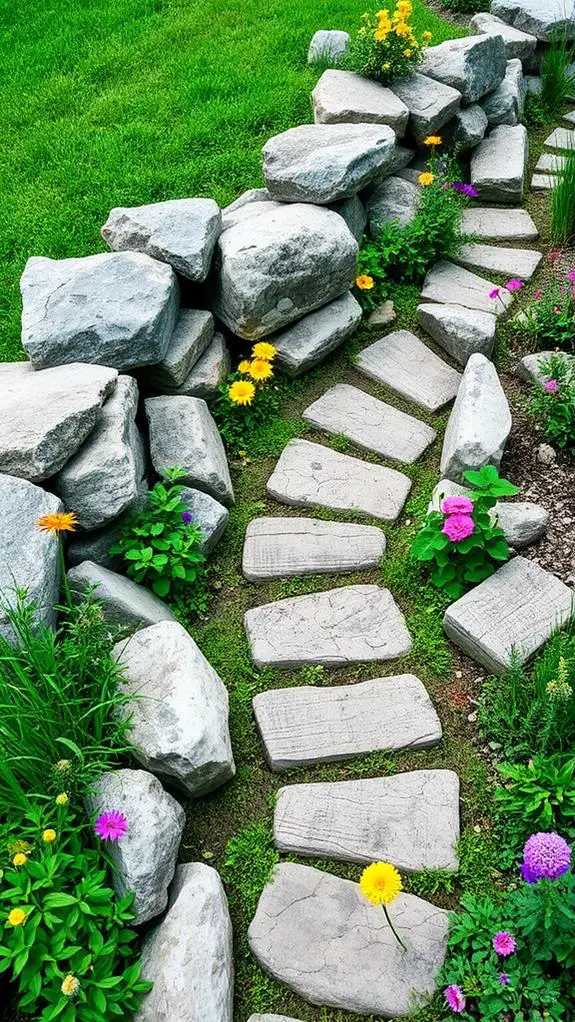
Defining the boundaries of your rock garden with a well-crafted border creates a sense of containment, visually separating the garden from the surrounding landscape.
When building a rock garden border, you'll want to choose materials that complement your rock formation. Consider using natural stone or brick for a cohesive look.
For a more modern take, try incorporating metal or recycled materials into your garden edging. Be mindful of the border's width and height, as it should be proportional to the size of your garden.
A well-designed border won't only define your space but also add visual interest and texture to your overall design. By carefully selecting your materials and design, you'll create a beautiful and functional border that enhances your rock garden.
Incorporating Decorative Statues

You'll want to strategically position your decorative statues to create visual interest and balance in your rock garden.
Consider placing statues among large rocks or boulders to create a sense of harmony and proportion. By doing so, you'll create a rocky statue display that draws the eye and adds depth to your garden.
Statue Placement Tips
When incorporating decorative statues into your rock garden, strategically placing them can elevate the overall aesthetic and create a visually appealing atmosphere.
To achieve this, consider statue grouping, where multiple statues are placed together to create a focal point. Alternatively, try statue clustering, where statues are scattered throughout the garden to create visual interest.
When placing statues, consider the scale, texture, and color of the surrounding rocks and plants. Balance large statues with smaller ones, and contrast smooth textures with rough ones.
Rocky Statue Displays
To create a striking rocky statue display, position your decorative statues amidst a carefully curated arrangement of rocks, boulders, and pebbles, allowing the natural textures and colors of the stone to complement the statue's features.
This harmonious blend of rocky themes and statue meanings will evoke a sense of serenity and connection to nature.
Consider the statue's proportions and placement to create a visually appealing contrast with the surrounding rocks.
Balance large statues with smaller rocks and pebbles, while smaller statues can be paired with larger boulders.
Experiment with different heights, angles, and groupings to achieve a unique, eye-catching display that showcases your statue's beauty amidst the rocky landscape.
Adding a Small Water Feature
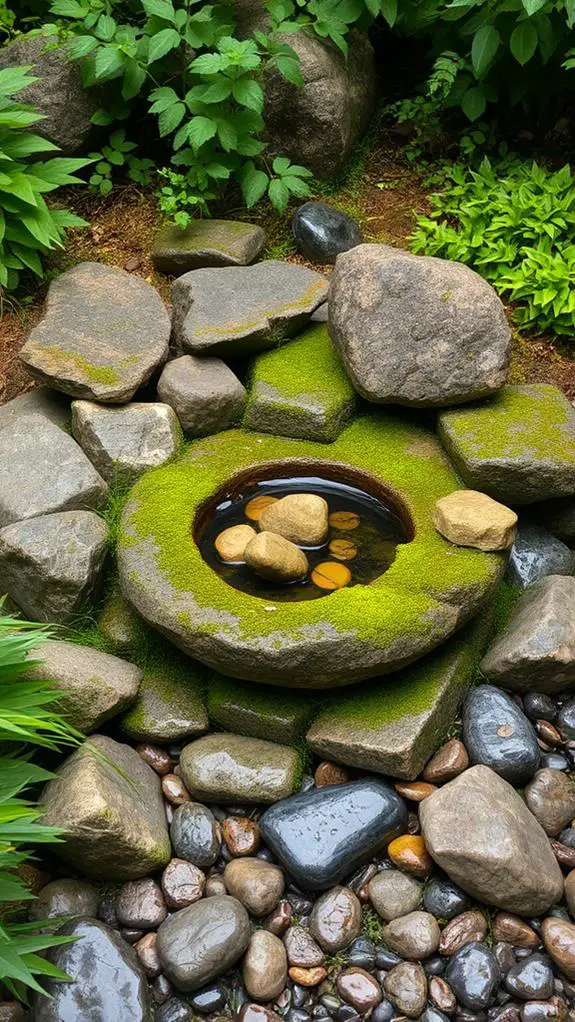
A tranquil oasis awaits with the addition of a small water feature to your rock garden.
You can create a soothing atmosphere by incorporating water sounds, such as gentle trickling or soft bubbling, to mask background noise and attract wildlife.
Choose from various fountain types, like spouting, cascading, or wall-mounted designs, to suit your garden's style and space constraints.
Consider a self-contained fountain or a small pond with a solar-powered pump to minimize maintenance.
Certify proper installation and placement to maximize visual appeal and create a sense of serenity.
Creating a Focal Point
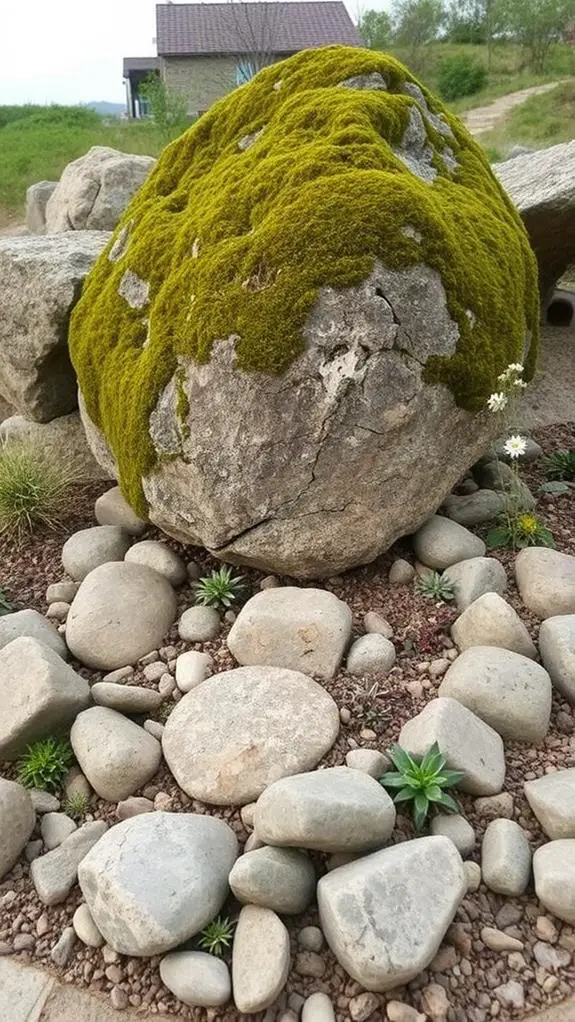
As you design your rock garden, you'll want to create a central attraction that draws the eye and anchors the space.
This focal point can take many forms, from a show-stopping boulder to a carefully crafted visual interest zone.
Rocky Centerpiece Ideas
Your rock garden's centerpiece is where the magic happens, drawing the eye to a specific area and setting the tone for the entire space.
You can create a stunning rocky centerpiece by combining large rocks, pebbles, and gravel in a harmonious arrangement.
Add some coastal vibes by incorporating seashells, driftwood, or coral into your design.
Consider using rocky accents like a statement boulder or a grouping of smaller rocks in varying textures and colors.
You can also incorporate plants with coastal flair, like succulents or beach grasses, to enhance the focal point.
Focal Point Features
To elevate your rocky centerpiece, incorporate focal point features that draw the eye and create visual interest.
You can achieve this by creating rock formations that rise from the ground, using a combination of large and small rocks to create depth and dimension.
Statement boulders can also serve as a striking focal point, especially when placed strategically to anchor the design.
Consider grouping smaller rocks around a larger statement piece to create a sense of movement and energy.
Visual Interest Zones
Creating visual interest zones within your rock garden is essential for guiding the viewer's eye to specific areas of the design.
You can achieve this by incorporating contrasting elements that create visual interest. For instance, combine rough, weathered rocks with smooth, polished stones to create a Texture Mix that draws the eye.
Visual Contrast can be achieved by juxtaposing light and dark colors, or by using plants with varying leaf shapes and sizes.
Using Mulch and Groundcover
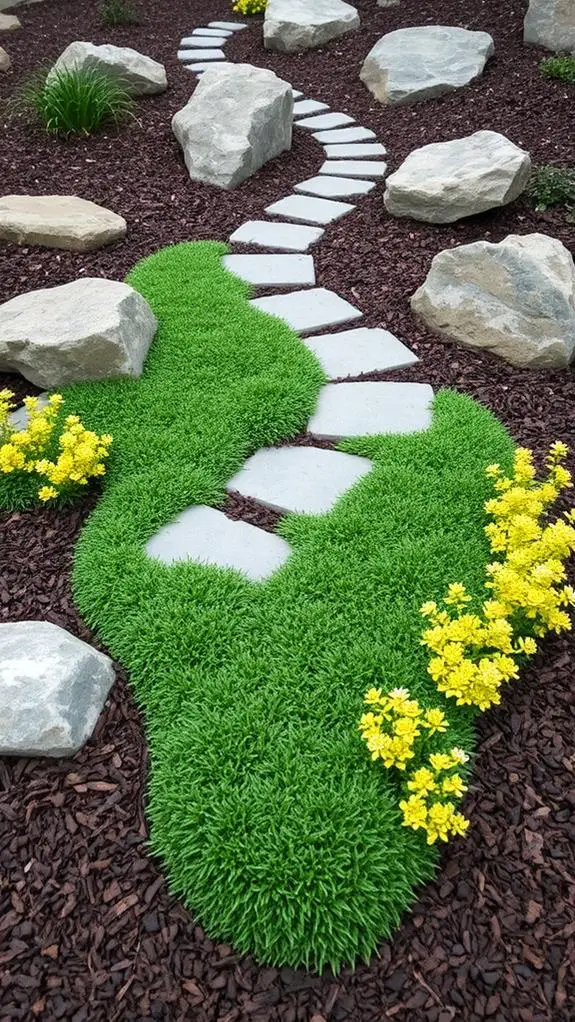
Several inches of mulch and a blanket of groundcover can transform your rock garden into a lush oasis.
You'll reap mulch benefits like reduced soil erosion, improved soil health, and suppressed weed growth. As you choose a groundcover, consider alternatives like thyme, creeping juniper, or sedum, which can thrive in poor soil and withstand foot traffic.
When selecting mulch, opt for organic materials like bark chips, pine straw, or leaves, which break down over time and add nutrients to the soil. Apply a 2-3 inch layer, keeping it a few inches away from plant stems.
This dynamic duo will create a cohesive, low-maintenance space that's both functional and visually stunning.
Incorporating Natural Elements
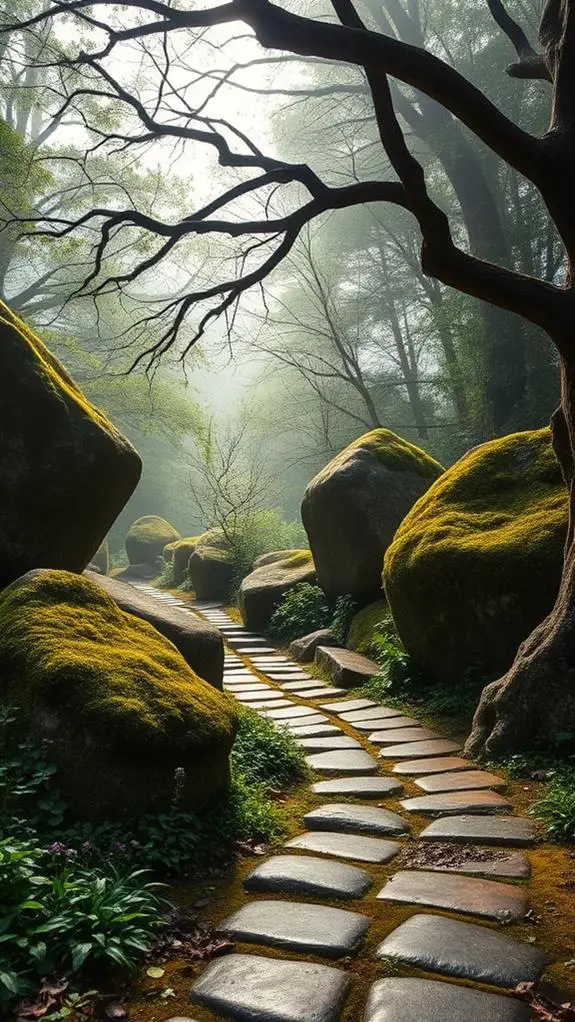
Beyond the rocks themselves, incorporating natural elements can elevate your rock garden to a harmonious blend of textures and tones.
You'll want to balance earth tones with nature accents to create visual interest. Consider adding driftwood, pinecones, or branches to introduce organic shapes and textures.
Mosses and lichens can also be used to add a touch of greenery to your design. When selecting natural elements, think about the colors and textures you want to highlight in your rock garden.
For example, if you're using dark rocks, balance them with lighter earth tones like sand or gravel. By thoughtfully incorporating natural elements, you'll create a rock garden that feels like an extension of the natural world.
Adding Outdoor Lighting

Illuminate your rock garden's unique features by strategically placing outdoor lighting.
This will create an enchanting ambiance, especially during the evening hours. Install solar lanterns amidst the rocks and plants to create pools of warm light.
You can also weave string lights through the foliage to create a mesmerizing display of twinkling lights. Consider placing spotlights to highlight specific features, such as a statement rock or a decorative statue.
Building a Rock Garden Pathway
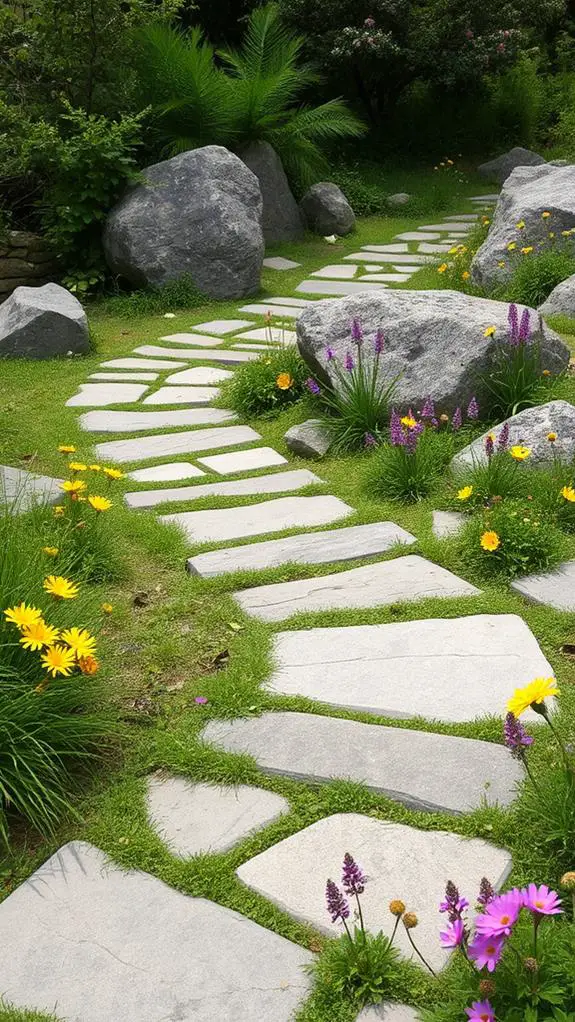
You'll need to choose rocks that complement your garden's color scheme and texture, considering factors like durability, size, and shape to create a cohesive look.
As you design your pathway, you can opt for a meandering route, a straight shot, or a combination of both, depending on the overall aesthetic you want to achieve.
Rock Selection Criteria
Three key factors determine the suitability of rocks for your garden pathway: size, shape, and texture.
You'll want rocks that are large enough to create a stable surface, yet small enough to allow for comfortable walking.
Angular rocks with rough textures can create a visually appealing contrast, while smooth rocks can add a touch of elegance.
Consider the color palette you want to achieve and select rocks that complement it.
For a natural look, choose rocks with earthy tones like brown, beige, and gray.
If you want to add a pop of color, incorporate rocks with vibrant hues like red, orange, or yellow.
Blending different rock types, such as granite, limestone, and sandstone, can create a unique and striking visual effect.
Pathway Design Options
Across your yard, a meandering rock garden pathway can unfold like a natural, organic extension of the landscape, inviting exploration and discovery.
As you design your pathway, consider incorporating rock patterns to create visual interest. You can alternate large and small rocks, or use a consistent size to create a sense of rhythm.
Pebble designs can also add texture and color. Try creating a mosaic pattern with small pebbles in different hues or using a single color to create a cohesive look.
To add depth, incorporate varying levels and curves, guiding visitors through your rock garden. By carefully selecting and arranging rocks and pebbles, you can create a unique and enchanting pathway that enhances your outdoor space.
Material Combination Ideas
With your pathway design in place, it's time to select the materials that will bring your rock garden to life.
You'll want to combine rocks with complementary textures to create visual interest. Consider pairing smooth, dark stones with rough, light-colored rocks for a striking contrast.
Next, choose a color scheme that ties in with your garden's overall aesthetic. Cool tones like blues and grays can evoke a calming atmosphere, while warm tones like oranges and yellows can add energy.
Don't forget to incorporate plants with varying foliage textures and colors to add depth and dimension. By thoughtfully combining these elements, you'll create a unique and mesmerizing rock garden pathway that invites exploration.
Creating a Themed Rock Garden
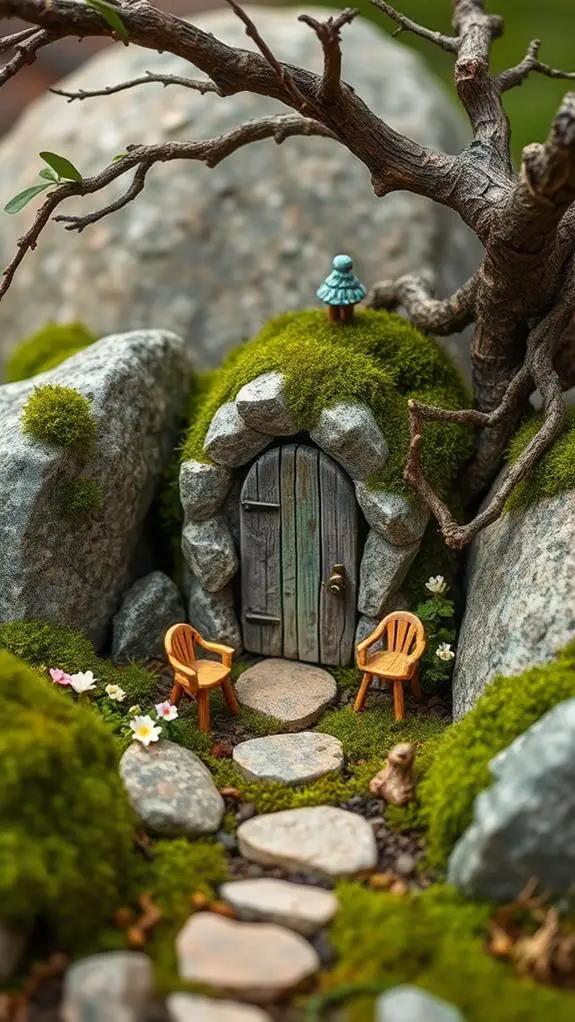
How do you envision your rock garden – a serene oasis or a vibrant spectacle?
Whatever your vision, creating a themed rock garden is a great way to add personality to your outdoor space.
Rock themes can range from desert landscapes to coastal vibes.
To create a coastal-themed rock garden, choose rocks with a weathered, beachy look and pair them with plants like succulents or beach sunflowers.
Add decorative elements like seashells, driftwood, or a miniature lighthouse to enhance the theme.
Consider a desert landscape theme, featuring cacti and bold, red rocks.
Alternatively, create a whimsical fairy garden with small, moss-covered stones and tiny ornaments.
The possibilities are endless, and the key is to have fun and be creative!
Maintaining Your Rock Garden
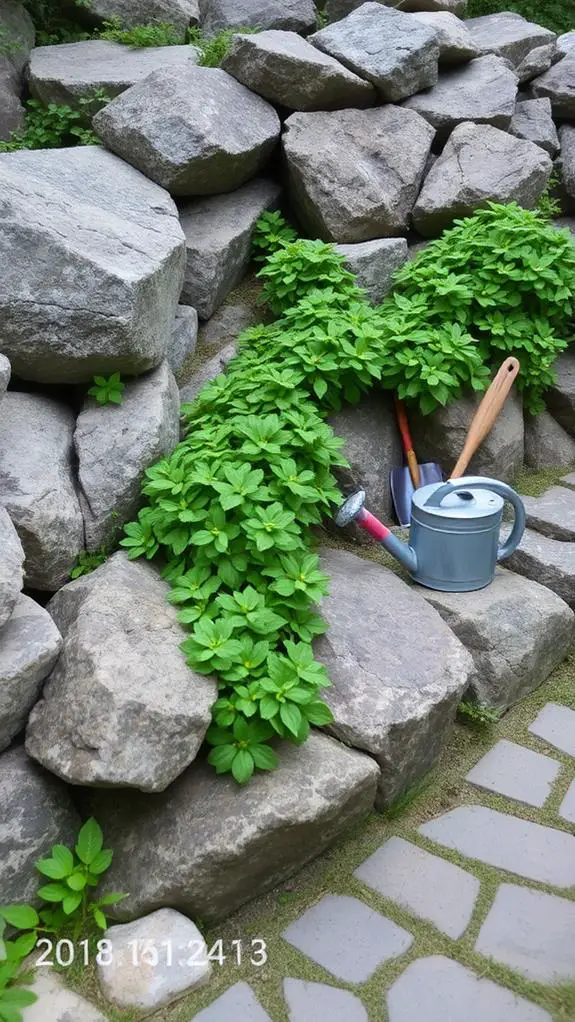
Your rock garden's beauty and tranquility depend on regular maintenance to prevent weeds from overtaking the design and compromising the health of your plants.
To keep your rock garden thriving, establish a seasonal maintenance routine. In spring, remove dead plant material and replenish mulch to suppress weeds.
Summer is the time for pruning and fertilizing plants, while autumn is ideal for dividing and replanting perennials.
During winter, protect plants from harsh weather by applying a layer of straw or burlap.
Additional rock garden tips include monitoring soil moisture, controlling pests, and making adjustments to your design as needed.
FAQs
Can I Create a Rock Garden in a Shaded Area?
You can thrive in a shaded landscape by choosing shade-loving plants that'll flourish in low-light conditions, such as ferns, hostas, and astilbe, which will add texture and color to your shaded rock garden oasis.
How Often Should I Water My Rock Garden Plants?
You'll want to water your plants when the top 2-3 inches of soil feel dry to the touch, typically every 7-10 days in spring and fall, and every 4-7 days in summer, after proper soil preparation with good drainage and aeration.
Will Weeds Grow Through the Rocks and Mulch?
You'll wonder if weeds will pierce through your carefully crafted landscape, but with a weed barrier and adequate rock depth (at least 2-3 inches), you'll create a formidable obstacle that prevents unwanted growth, ensuring your design remains pristine and weed-free.
Can I Use River Rocks in a Rock Garden Design?
You can use river rocks in your design, strategically placing them to create visually appealing river rock placement patterns. Select rock color schemes that complement your garden's aesthetic, and consider mixing sizes and shapes for added texture and depth.
Are Rock Gardens Suitable for Small Backyards?
You can overcome space constraints in small backyards by optimizing the layout, using vertical elements, and selecting compact plants, ultimately creating a visually stunning and functional oasis that maximizes every inch of your outdoor space.
Conclusion
As you step back to admire your handiwork, your DIY rock garden transforms into a serene oasis or vibrant spectacle. You've carefully selected rocks that harmonize with the garden's color scheme and texture, paired them with low-maintenance plants, and strategically positioned statues for visual interest. The meandering pathway, outdoor lighting, and natural elements like driftwood or mosses evoke a sense of tranquility. Your rock garden is now a stunning focal point in your outdoor space, awaiting your relaxation and enjoyment.


